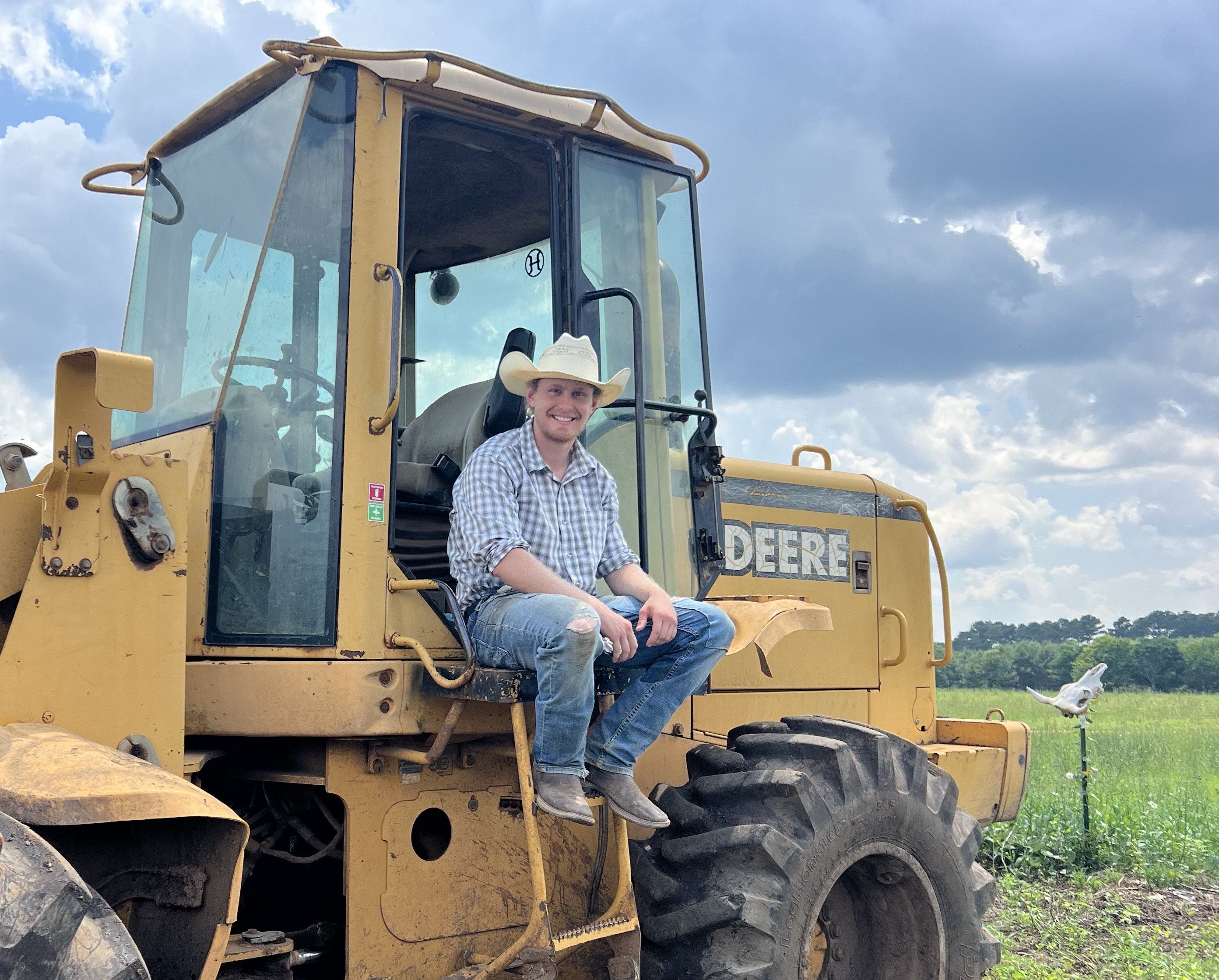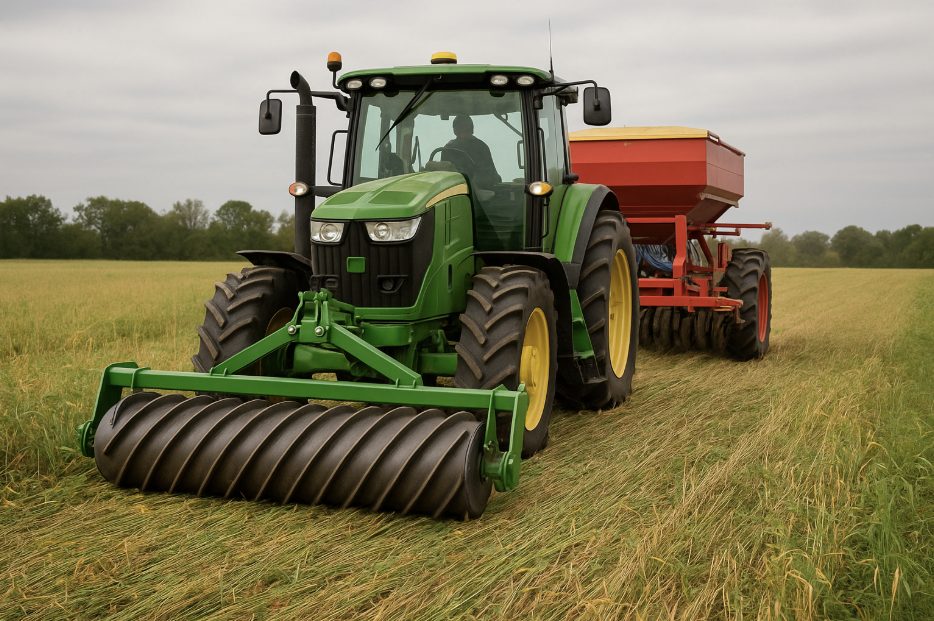TheFarmersDigest
The Farmers Digest
May 24, 2025

Editor
Chris Pigge

Editor
Miles Falk
Roller Crimping: What, How, and Why
Farmers across the country are rediscovering an old truth: sometimes the simplest tools solve the most persistent problems. While herbicides have dominated cover crop termination for decades, many producers are turning back to a mechanical approach that's gaining traction in both organic and conventional systems—the roller crimper.
This tool represents farming at its most straightforward: if you want plants to die without chemicals, crush their stems. Nature handles the rest. What's old is new again, and many farmers are finding that roller crimping fits perfectly within modern sustainable agriculture.
What Is a Roller Crimper?
A roller crimper is essentially a water-filled drum with blunt metal blades or chevron-shaped bars mounted across its surface. When pulled across a field, it rolls over standing cover crops, crimping their stems every few inches without actually cutting them. This crimping action breaks the plant's vascular system, preventing water and nutrients from flowing between roots and leaves.
Unlike mowing, which cuts plants into pieces and often stimulates regrowth, crimping leaves the plant intact but mortally wounded. The result is a uniform mat of slowly dying cover crop that remains anchored in place by its own root system—creating a natural mulch layer right where you need it.
Most farmers mount their crimpers on the front of tractors, with planters hitched behind. This setup allows for crimping and planting in a single pass, saving time and reducing soil compaction. The crimper knocks cover crops down in front of the tractor while the planter places seeds directly into this newly created mulch.
According to research from the Rodale Institute, which pioneered many of the early roller crimper designs, this front-mounted configuration can reduce field operations compared to conventional termination and tillage approaches, representing significant savings in both fuel and labor.

The Science of Good Timing
If roller crimping has an Achilles' heel, it's timing. While herbicides can effectively terminate plants at almost any growth stage, crimping works best when cover crops have reached a specific physiological point in their lifecycle.
For cereal rye, the most commonly used cover crop for crimping, this critical moment occurs at anthesis (flowering) or the early milk stage of seed development. Studies from several universities have documented that crimping at this stage consistently achieves effective termination, while crimping just one week earlier may result in significant regrowth.
At the flowering stage, the plant has already directed most of its energy into reproduction rather than regrowth, making it vulnerable to mechanical termination. Crimp too early and the cover crop bounces back, competing with your cash crop. Wait too long and you might miss your optimal planting window.
This explains why many farmers start with crimping rye before planting soybeans—this pairing offers a forgiving timeline where rye typically reaches its ideal crimping stage right around the optimal soybean planting window.
Field studies from multiple agricultural research stations confirm that learning to identify these growth stages visually is much more reliable than following calendar dates, which can vary significantly from year to year based on weather conditions.
Why Farmers Are Switching to Crimpers
While reducing herbicide use might be the most obvious reason to consider roller crimping, research points to multiple benefits that extend well beyond chemical savings. The weed control achieved through this method is truly remarkable. A properly crimped cover crop creates a thick, uniform mat that suppresses weeds both physically and chemically. Cereal rye releases natural compounds (allelopathic chemicals) as it decomposes that inhibit small-seeded annuals.
Studies from the University of Wisconsin and other institutions have documented significant reductions in weed pressure in properly managed crimped rye systems, often eliminating the need for additional herbicide applications throughout the growing season.
The water conservation benefits have convinced many drought-prone operations to adopt crimping. According to research from the University of Nebraska, the residue layer acts like a protective blanket over the soil, reducing evaporation throughout the growing season. During recent drought years, moisture monitoring has shown that fields with crimped cover crops consistently maintained soil moisture longer than bare fields or those with standing stubble.
Temperature management represents another significant advantage that impacts both soil biology and crop performance. Studies from Michigan State University have documented that the mulch layer moderates soil temperature extremes during summer heat waves. This temperature buffering creates better growing conditions for both soil microbes and cash crop roots, potentially extending the growing season on both ends.
Erosion control might be the most visually dramatic benefit after heavy rainfall events. Research from the USDA Agricultural Research Service has documented that with high soil coverage, crimped fields experienced substantially less erosion compared to conventionally tilled fields. Unlike fields with standing cover crops, which can still experience erosion between plants, a crimped mat provides uninterrupted protection against even the heaviest downpours.
The biodiversity benefits often surprise first-time crimpers. Studies from the University of Illinois have found that the structured environment between soil and mulch becomes prime habitat for ground beetles, spiders, and other beneficial insects that prey on crop pests. This natural pest control service comes standard with crimping operations, often reducing the need for insecticide applications as predator populations establish themselves in the protective environment of the residue mat.
Roller Crimping By The Numbers
Based on research from various agricultural institutions, roller crimping offers several quantifiable benefits:
- 60-80%Weed biomass reduction under properly crimped cereal rye compared to bare ground (Penn State University)
- 25-35%Moisture retention throughout the growing season from reduced evaporation under cover crop mulch (University of Nebraska)
- 90%+Erosion reduction compared to conventionally tilled fields during heavy rainfall events (USDA ARS)
- 15-20°FSoil temperature moderation during summer heat extremes (Michigan State University)
- 3-5 mphOptimal operating speed for most roller crimper designs (NRCS guidelines)
- $150-400/acreTypical equipment cost range for commercial roller crimpers (Iowa State University)
The Real-World Trade-Offs
Every farming practice comes with challenges, and roller crimping is no exception. Understanding these trade-offs helps set realistic expectations. The equipment investment is often the first consideration for farmers exploring this technique.
According to economic analyses from Iowa State University, while this investment is not insignificant, many operations can recover costs within a few seasons through reduced herbicide expenses and improved weed control. Several manufacturers now offer models in various sizes to match different farm scales and tractor horsepower ranges.
The timing window presents perhaps the most significant management challenge. Research from the University of Maryland has shown that the period for effective crimping can sometimes be just a few days for certain cover crops. Weather delays during this critical window can force difficult decisions about prioritizing crimping versus other field operations. Experienced practitioners typically develop backup plans for when optimal timing and weather don't align perfectly.
Multiple studies have documented a learning curve associated with adopting this practice. According to research from the Sustainable Agriculture Research and Education (SARE) program, success rates improve with experience as farmers become more familiar with timing and technique. Working with experienced crimpers or extension specialists can significantly shorten this learning period.
The system relies heavily on successful cover crop establishment. Research from Ohio State University confirms that roller crimping works most effectively with a thick, uniform stand of cover crops generating sufficient biomass per acre. Patchy coverage leads to patchy weed control, making successful crimping dependent on successful cover crop establishment the previous season. Investing in good cover crop management becomes even more critical when planning to terminate with a roller crimper.
Different Crimping Approaches for Different Farms
No single approach works for all operations, and agricultural engineers have developed various roller crimping systems to match different equipment, labor availability, and comfort levels. Front-mount systems represent the gold standard for efficiency. According to equipment evaluations from the University of Nebraska, with the crimper mounted on the front of the tractor and a planter behind, this configuration allows single-pass operation with reduced fuel usage compared to separate termination and planting operations. The front-mount approach is most efficient for larger operations but requires specialized mounting equipment that works with particular tractor models.
Many operations start with pull-behind models that offer more flexibility with less initial investment. Research from Purdue University indicates this approach involves crimping in one pass followed by planting in a second pass. While it requires more field traffic, it works with standard equipment configurations and offers more flexibility with timing. The two-pass system also allows for adjustment periods between crimping and planting if conditions aren't ideal for both operations on the same day.
The agricultural engineering community has documented numerous homemade solutions emerging across farm country. According to case studies compiled by ATTRA (National Sustainable Agriculture Information Service), many producers modify existing equipment like cultimulchers or build their own crimpers using pipe, drum rollers, and angle iron. While perhaps not as consistently effective as commercial units, these DIY solutions can be remarkably affordable entry points, often costing less in materials. The ability to customize these units to match specific field conditions and tractor setups offers additional advantages for mechanically inclined farmers.
A survey from the Conservation Technology Information Center found that many farmers achieve success with targeted implementation rather than wholesale adoption. Using crimping in specific fields or rotations where it makes the most sense, while maintaining conventional practices elsewhere, allows producers to gain experience before broader implementation. This gradual approach minimizes risk while building confidence and expertise with the new technique.
Getting Started With Roller Crimping
If you're considering trying roller crimping, research indicates a thoughtful, step-by-step approach will maximize your chances of success. Studies from multiple land-grant universities consistently recommend beginning with the simplest, most reliable combination – cereal rye before soybeans. This pairing offers the most forgiving timing and the most consistent results for beginners.
The natural growth cycle of rye typically aligns well with soybean planting dates in most regions, creating a natural fit that minimizes timing conflicts. The vigorous spring growth of rye also provides substantial biomass for effective weed suppression throughout the soybean growing season.
Research from the University of Wisconsin emphasizes the importance of establishing substantial cover crop biomass, as this is the foundation of the system's success. Their field trials show that a thick stand of rye provides the weed suppression that makes roller crimping work. Thin or patchy stands lead to disappointment and weed breakthroughs. Consider increasing your normal cover crop seeding rate when planning for crimping rather than chemical termination.
Educational materials from Cornell University stress the importance of learning to identify growth stages in your cover crop. For cereal rye, the visible signs of anthesis (yellow pollen shedding) and early milk stage (squeezing a seed produces milky liquid) are the critical timing indicators. These biological markers are far more reliable than calendar dates, which can vary significantly between seasons based on temperature patterns and growing conditions. Extension specialists recommend taking photos of cover crops at these stages for future reference.
Adoption studies from Practical Farmers of Iowa suggest starting with a modest trial area rather than converting an entire operation at once. Their on-farm research network has documented that farmers who try crimping on limited acreage before making broader commitments consistently report higher satisfaction and success rates. This approach allows for comparing results, refining techniques, and building confidence without risking significant production areas. Even a 5-10 acre test plot provides valuable experience without overwhelming new practitioners.
The North Central Sustainable Agriculture Research and Education program recommends connecting with experienced crimpers through farmer networks, field days, and soil health groups. Their farmer-to-farmer education model has proven particularly effective with complex practices like roller crimping. Some equipment dealers and conservation districts even offer demonstrations or rental units to try before buying. This community knowledge can help avoid common pitfalls and accelerate the learning curve considerably.
Research from the University of Illinois highlights the importance of making adjustments to planting equipment. Their field trials demonstrate that establishing good seed-to-soil contact through a crimped mat may require modifications to planter down pressure, closing wheels, and row cleaners. Focusing on these details makes the difference between struggling seedlings and vigorous crop establishment. Many manufacturers now offer specific equipment designed for planting into high-residue environments.

Conclusion
Roller crimping represents one of those practical innovations that manages to simultaneously reduce costs, improve soil health, and enhance environmental outcomes. While not a silver bullet for every farming challenge, it offers a viable path toward reducing chemical dependence while maintaining or improving productivity.
By working with natural plant cycles rather than fighting them, roller crimping exemplifies an approach to agriculture that builds resilience rather than requiring ever-increasing interventions. Whether you're an organic producer seeking better weed management or a conventional farmer looking to reduce input costs, roller crimping deserves consideration as part of your soil health toolkit.
The beauty of the roller crimper lies in its straightforward approach to a complex problem. In an age of high-tech agriculture, sometimes the most effective solutions are refreshingly simple—just a heavy drum with some metal bars, relying on gravity and plant biology to do the real work. It's farming at its most elemental: working with natural processes rather than against them.
References
Penn State University Extension. Suppressing Weeds Using Cover Crops in Pennsylvania.
University of Nebraska CropWatch. Long-term UNL Study Examines Impacts of Cover Crops on Soil Water.
Soil Health Institute. Maximizing Weed Suppression with Cover Crops in Cotton Production.
USDA ARS. Managing Cover Crops with Rolling and Crimping Techniques.
Iowa State University Vegetable Lab. Roller-Crimper in Action.
SARE. Roller-Crimper Equipment and Effectiveness.
USDA Natural Resources Conservation Service.
University of Florida IFAS Extension. Cover Crop Roller Crimpers.
Practical Farmers of Iowa. Three Experiences with Roller-Crimping Cover Crops.